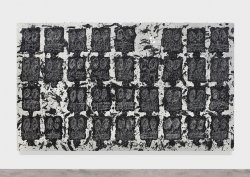MFA Studio Art Student Stephanie O’Connor Responds to Rashid Johnson’s Exhibition “Fly Away” in New York City
Posted in: Announcements

Rashid Johnson’s exhibition entitled Fly Away, is currently on view until October 22nd at Hauser & Worth gallery who states, “the exhibition reveals Johnson pondering themes of history, yearning, and escape while intensifying his longstanding investigation into the relationship between art, society, and personal identity.”
On Tuesday, September 20th, Art Critical: the Online Magazine of Art and Ideas presented The Review Panel, which critically discussed the exhibition at their new home in the Brooklyn Public Library. It included New York art critic and Montclair State University MFA Studio Arts Visiting Critic Ken Johnson, moderator David Cohen, art historian and curator Karen E. Jones, and associate editor Noah Dillon. This diverse group of critics explored Rashid Johnson’s Fly Away exhibition in detail, noting the repetition of black soap faces and other pieces using diverse materials, the mimicry of production aesthetics, rich colors, and dialogue about racism. MFA Studio Art Professor and Co-Director, Julie Heffernan invited the Montclair State MFA Studio Arts students to join her in this interesting discussion.
MFA Studio Art student, Stephanie O’Connor felt that a very important aspect was overlooked. She significantly impressed the attentive group of critics as well as audience members when she publicly spoke about the confronting message she believes Johnson is communication. “Africa has been used as a kind of product for colonizing powers throughout history. For centuries, Africa has been exploited for its natural resources and people. Tragically, Africans have been brutally turned into products themselves by being forced into slavery, even up until today.” Stephanie continued, “ The reason I believe Rashid uses repetition in his work is to correlate it to mass production of goods equaling mass production of Africa and Africans used as commodities themselves.” O’Connor suggests that Johnson’s Anxious Audience pieces are the visual representation of anxious Africans throughout time, due to their vicious history of abuse and violence.
